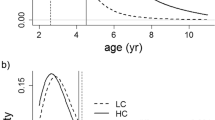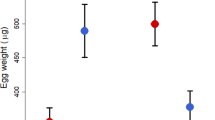Abstract
In many animal societies where hierarchies govern access to reproduction, the social rank of individuals is related to their age and weight1,2,3,4,5 and slow-growing animals may lose their place in breeding queues to younger ‘challengers’ that grow faster5,6. The threat of being displaced might be expected to favour the evolution of competitive growth strategies, where individuals increase their own rate of growth in response to increases in the growth of potential rivals. Although growth rates have been shown to vary in relation to changes in the social environment in several vertebrates including fish2,3,7 and mammals8, it is not yet known whether individuals increase their growth rates in response to increases in the growth of particular reproductive rivals. Here we show that, in wild Kalahari meerkats (Suricata suricatta), subordinates of both sexes respond to experimentally induced increases in the growth of same-sex rivals by raising their own growth rate and food intake. In addition, when individuals acquire dominant status, they show a secondary period of accelerated growth whose magnitude increases if the difference between their own weight and that of the heaviest subordinate of the same sex in their group is small. Our results show that individuals adjust their growth to the size of their closest competitor and raise the possibility that similar plastic responses to the risk of competition may occur in other social mammals, including domestic animals and primates.
This is a preview of subscription content, access via your institution
Access options
Subscribe to this journal
Receive 51 print issues and online access
$199.00 per year
only $3.90 per issue
Buy this article
- Purchase on Springer Link
- Instant access to full article PDF
Prices may be subject to local taxes which are calculated during checkout


Similar content being viewed by others
References
Hoogland, J. L. The Black-Tailed Prairie Dog: Social Life of a Burrowing Mammal (Univ. Chicago Press, 1995)
Buston, P. Social hierarchies: size and growth modification in clownfish. Nature 424, 145–146 (2003)
Heg, D., Bender, N. & Hamilton, I. Strategic growth decisions in helper cichlids. Proc. R. Soc. Lond. B 271, S505– S508 (2004)
Spong, G. F., Hodge, S. J., Young, A. J. & Clutton-Brock, T. H. Factors affecting the reproductive success of dominant male meerkats. Mol. Ecol. 17, 2287–2299 (2008)
Clutton-Brock, T. H. et al. Intrasexual competition and sexual selection in cooperative mammals. Nature 444, 1065–1068 (2006)
Reeve, H. K., Peters, J. M., Nonacs, P. & Starks, P. T. Dispersal of first “workers” in social wasps: causes and implications of an alternative reproductive strategy. Proc. Natl Acad. Sci. USA 95, 13737–13742 (1998)
Wong, M. Y. L., Munday, P. L., Buston, P. M. & Jones, G. P. Fasting or feasting in a fish social hierarchy. Curr. Biol. 18, R372–R373 (2008)
Dantzer, B. et al. Density triggers maternal hormones that increase adaptive offspring growth in a wild mammal. Science 340, 1215–1217 (2013)
Hauber, M. E. & Lacey, E. A. Bateman’s principle in cooperatively breeding vertebrates: the effects of non-breeding alloparents on variability in female and male reproductive success. Integr. Comp. Biol. 45, 903–914 (2005)
Russell, A. F., Carlson, A. A., McIlrath, G. M., Jordan, N. R. & Clutton-Brock, T. Adaptive size modification by dominant female meerkats. Evolution 58, 1600–1607 (2004)
Young, A. J. & Bennett, N. C. Morphological divergence of breeders and helpers in wild Damaraland mole-rat societies. Evolution 64, 3190–3197 (2010)
Dengler-Crish, C. M. & Catania, K. C. Phenotypic plasticity in female naked mole-rats after removal from reproductive suppression. J. Exp. Biol. 210, 4351–4358 (2007)
Clutton-Brock, T. Structure and function in mammalian societies. Phil Trans R Soc B 364, 3229–3242 (2009)
Clutton-Brock, T. H. et al. Evolution and development of sex differences in cooperative behavior in meerkats. Science 297, 253–256 (2002)
Thavarajah, N. K., Fenkes, M. & Clutton-Brock, T. H. The determinants of dominance relationships among subordinate females in the cooperatively breeding meerkat. Behaviour 151, 89–102 (2014)
Doolan, S. P. & Macdonald, D. W. Dispersal and extra-territorial prospecting by slender-tailed meerkats (Suricata suricatta) in the south-western Kalahari. J. Zool. 240, 59–73 (1996)
O’Riain, M. J., Jarvis, J. U., Alexander, R., Buffenstein, R. & Peeters, C. Morphological castes in a vertebrate. Proc. Natl Acad. Sci. USA 97, 13194–13197 (2000)
Carlson, A. A. et al. Hormonal correlates of dominance in meerkats (Suricata suricatta). Horm. Behav. 46, 141–150 (2004)
Young, A. J., Monfort, S. L. & Clutton-Brock, T. H. The causes of physiological suppression among female meerkats: a role for subordinate restraint due to the threat of infanticide? Horm. Behav. 53, 131–139 (2008)
Dantzer, B. & Swanson, E. M. Mediation of vertebrate life histories via insulin-like growth factor-1. Biol. Rev. Camb. Phil. Soc. 87, 414–429 (2012)
Arendt, J. D. Adaptive intrinsic growth rates: an integration across taxa. Q. Rev. Biol. 72, 149–177 (1997)
Metcalfe, N. B. & Monaghan, P. Compensation for a bad start: grow now, pay later? Trends Ecol. Evol. 16, 254–260 (2001)
Clutton-Brock, T. H. et al. Predation, group size and mortality in a cooperative mongoose, Suricata suricatta. J. Anim. Ecol. 68, 672–683 (1999)
Clutton-Brock, T. H. & Huchard, E. Social competition and selection in males and females. Phil. Trans. R. Soc. B 368, 20130074 (2013)
English, S., Bateman, A. W. & Clutton-Brock, T. H. Lifetime growth in wild meerkats: incorporating life history and environmental factors into a standard growth model. Oecologia 169, 143–153 (2012)
Sharp, S. P., English, S. & Clutton-Brock, T. H. Maternal investment during pregnancy in wild meerkats. Evol. Ecol. 27, 1033 (2013)
Young, A. J., Spong, G. & Clutton-Brock, T. Subordinate male meerkats prospect for extra-group paternity: alternative reproductive tactics in a cooperative mammal. Proc. R. Soc. B 274, 1603–1609 (2007)
R Development Core Team. R: A Language and Environment for Statistical Computing. http://www.R-project.org/ (2015)
Acknowledgements
We are grateful to the many volunteers, field managers, PhD students and post-doctoral researchers who have contributed to data collection over the past 15 years, and to D. Gaynor, I. Stevenson, P. Roth, J. Samson, R. Millar, E. Cameron, J. du Toit and M. Haupt for support. We are grateful to M. Manser for her contribution to the organization of the Kalahari Meerkat Project and to C. Drea for additional help and advice. We also thank D. Cram for comments on previous drafts, and A. Bateman, A. Courtiol and M. Crawley for statistical advice. Northern Cape Conservation and the Kotze family provided permission to work in the Kalahari. Our work was approved by the Animal Ethics Committee of the University of Pretoria (project number EC010-13). The Kalahari Meerkat Project is supported and organized by the Universities of Cambridge and Zurich. This research was supported by the Natural Environment Research Council (grant NE/G006822/1) and the European Research Council (grant 294494).
Author information
Authors and Affiliations
Contributions
E.H. implemented the analysis and drafted the results; T.H.C.-B., S.E. and M.B. planned the experiments, which were conducted by N.T. and other members of the Kalahari Meerkat Project; E.H., S.E., M.B. and T.H.C.-B. wrote the paper.
Corresponding author
Ethics declarations
Competing interests
The authors declare no competing financial interests.
Extended data figures and tables
Extended Data Figure 1 Diagram depicting the experimental design.
Juvenile experiments were conducted from 15 December 2010 to 19 August 2012, and adult experiments from 28 March 2011 to 20 July 2013. Each horizontal line represents longitudinal weight data collected from an experimental group. Thick orange lines represent unfed, challenged individuals and blue lines represent fed challengers. Thick green lines represent control individuals, which were animals of the same sex and age-range from the same population over the same period (2010–2013). Red boxes indicate the 3-month experimental windows of food supplementation, which spanned different periods for different dyads (allowing us to disentangle experimental effects from environmental and seasonal effects on weight) and, for the adult experiment, occurred any time between 310 and 870 days of age. F, female; M, male. Note that the x axis is not drawn to scale, to facilitate comparison of the design between the juvenile and adult cohorts. The meerkat icon was downloaded from PhyloPic: http://phylopic.org, with credit to M. Keesey.
Extended Data Figure 2 Relationship between the growth of the challenged individual and the growth of its fed challenger.
a, Juveniles; b, adults. Thirty-two juvenile and 17 adult experimental pairs were included. Growth was calculated as the individual weight difference between the start and mid-point of the experiment. Dots show the raw values (grey for females, black for males). The dotted line shows the predicted values of the linear model (results presented in Extended Data Table 1) and s.d. of the predicted values are delineated by shaded areas.
Extended Data Figure 3 Changes in weight and food intake (average morning weight gain) in new dominant females (grey boxes, n = 42) and males (black boxes, n = 30).
a, Weight; b, food intake. Boxplots show the raw values, averaged for each individual during the month preceding dominance acquisition (labelled ‘0’), as well as during the first, second, third and fourth months’ post-dominance acquisition (respectively labelled ‘1’, ‘2’, ‘3’ and ‘4’). Whiskers show all data points that are no further away from the box than half the interquartile range.
PowerPoint slides
Rights and permissions
About this article
Cite this article
Huchard, E., English, S., Bell, M. et al. Competitive growth in a cooperative mammal. Nature 533, 532–534 (2016). https://doi.org/10.1038/nature17986
Received:
Accepted:
Published:
Issue Date:
DOI: https://doi.org/10.1038/nature17986
This article is cited by
-
Bergmann’s rule is a “just-so” story of human body size
Journal of Physiological Anthropology (2022)
-
Vertebrate growth plasticity in response to variation in a mutualistic interaction
Scientific Reports (2022)
-
Ecological evidence of hierarchy and competition in Didelphis aurita females
Mammalian Biology (2022)
-
An intergenerational androgenic mechanism of female intrasexual competition in the cooperatively breeding meerkat
Nature Communications (2021)
-
Stunting is not a synonym of malnutrition
European Journal of Clinical Nutrition (2020)
Comments
By submitting a comment you agree to abide by our Terms and Community Guidelines. If you find something abusive or that does not comply with our terms or guidelines please flag it as inappropriate.



